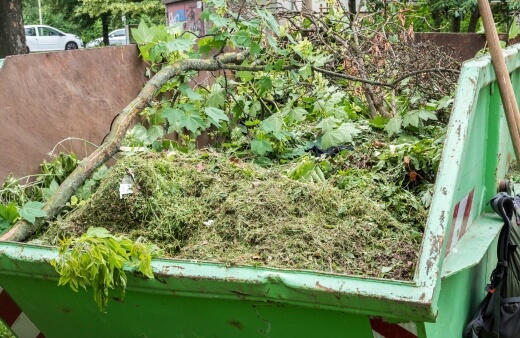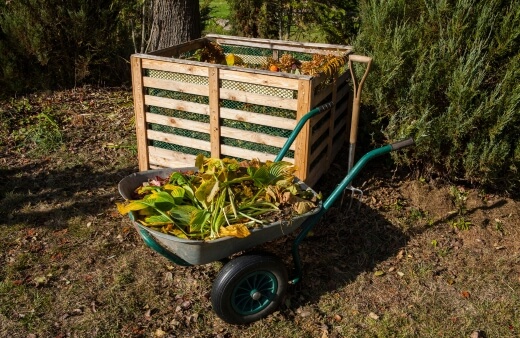Waste management is a major concern for all Australians as the population grows and the volume of rubbish we produce expands along with it. This includes green waste. Even though organic material is biodegradable, it can still present a major problem for Australia if it is not processed correctly.
Whether it is a trip to the tip or calling in professional green waste removal services, as a gardener, understanding the correct methods for green waste disposal is vital.
More...
Australian Guide to Green Waste Removal

What Can and Can’t Be Included in Green Waste?
According to the Australian Bureau of Statistics, in 2018-2019, Australians generated approximately 15.3 million tonnes of organic waste, which includes green waste. However, only 6.4 million tonnes (42 per cent) of this organic waste was diverted from landfill for processing, highlighting the need for more efficient green waste disposal practices and awareness around can and can’t be included in green waste.
Green waste can include anything that is biodegradable and organic. Some examples of green waste include:
- Leaves
- Grass clippings
- Ash (cold)
- Bamboo food containers and cutlery
- Bones (meat and fish)
- Coffee grinds
- Compostable bin liners (Council approved)
- Cardboard food containers
- Food scraps
- Flowers and dead plants
- Twigs and branches
- Grains (e.g. pasta, bread, rice, noodles)
- Hair
- Tea bags
- Manure (all animals).
Items not suitable for green waste removal may seem obvious, but did you know there are some organic waste items on that list as well? You might be surprised to the know the following items cannot be included in green waste removal:
- Treated timber or plywood
- Plastic plant pots
- Plastic bags and containers
- Metal objects or materials (e.g., nails, wire, or metal fencing)
- Glass items or materials (e.g., bottles, broken glass, or glassware)
- Rocks, stones, or large quantities of soil (some municipalities may accept small amounts of soil or sod, so make sure to check with your local council).
These materials can contaminate the green waste and make it difficult to process.

Why is Green Waste Removal Important?
Green waste removal is important for several reasons. Firstly, it helps to reduce the amount of waste that ends up in landfills. In Australia, it is estimated that around 50 per cent of all waste sent to landfills is organic material, much of which could be diverted to green waste processing facilities.
By diverting green waste from landfills, we can reduce greenhouse gas emissions and extend the life of landfills. Secondly, green waste can be processed into compost or mulch, which can be used to enrich soil and improve plant growth.
Composting green waste helps to reduce the need for synthetic fertilisers and pesticides, which can be harmful to the environment and human health.
What Happens to Green Waste?
Green waste is typically collected by local councils or private waste removal companies and transported to green waste processing facilities. At these facilities, the green waste is processed into mulch or compost.
The processing involves shredding the green waste into small pieces, which are then left to decompose. The decomposed material is then screened and sorted to remove any contaminants, such as plastic or metal.
The final product is high-quality mulch or compost, which can be used in gardening and landscaping projects.
Rules and Regulations for Green Waste Disposal in Australia
There are rules and regulations governing the disposal of green waste in Australia. The exact rules vary by state and territory, so it is important to check with your local council or waste removal company to find out the specific requirements in your area.
In general, green waste should be placed in designated green waste bins or bags, which are provided by the council or waste removal company. It is important to only include organic materials in the green waste, and to avoid including any contaminants such as plastic or metal.


Get Your Free Guide:
Master Growing Australian Natives eBook
A Must Have Complete Guide for Every Australian Garden
Get Your Free Guide:
Master Growing Australian Natives eBook
A Must Have Complete Guide for Every Australian Garden
It is also important to note that burning green waste is generally not permitted in urban areas. Burning green waste can cause air pollution and can be a fire hazard, especially during dry periods.
How to Dispose of Green Waste Efficiently and Effectively

There are several ways to dispose of green waste efficiently and effectively. Here are some tips:
Use a compost bin
Using a compost bin is an effective way to get rid of food scraps and yard waste, creating a nutrient rich fertiliser for your garden and preventing organic waste from reaching landfills at the same time.
Hire a skip bin
If you have a large amount of green waste to dispose of, consider hiring a skip bin. Skip bins are available in various sizes and can be delivered to your property for easy loading. Once the bin is full, it will be picked up and taken to a green waste processing facility.
Take green waste to a recycling facility
Some local councils have green waste recycling facilities where you can drop off your green waste for processing. Check with your council to see if this service is available in your area and what materials are accepted.
Use a garden waste removal service
If you don't have the time or resources to dispose of your green waste yourself, consider hiring a garden waste removal service. These services will collect your green waste and take it to a processing facility on your behalf.
Use green waste for landscaping
Green waste can be used in landscaping projects, such as creating paths or garden borders. This is a great way to repurpose the green waste and add a natural touch to your garden.
Wrapping Up Our Guide to Green Waste Removal in Australia
In summary, green waste removal is an important part of responsible gardening and landscaping. It is not enough to assume that dumping green and organic waste at the local tip is going to be enough, as there is too much green waste clogging Aussie landfills as it is.
By setting up some simple systems at home and hiring professional green waste services, every Aussie can make a significant difference. Not only does green waste removal improve the condition of the yard at home, it ensures Australia has a sustainable future for years to come.
Published on April 23, 2023 by Gary Clarke
Last Updated on September 3, 2024




